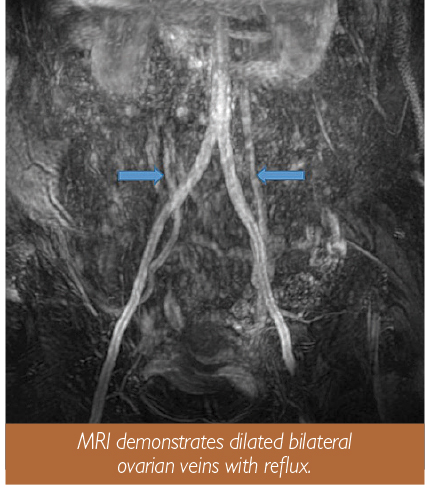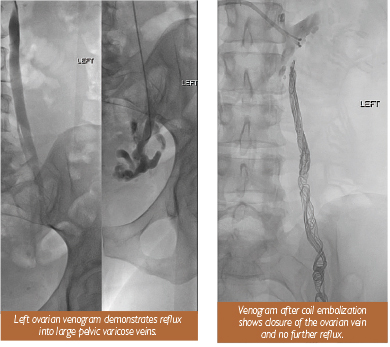|
Pelvic Congestion SyndromeJacques Tham, MD
Pelvic Congestion SyndromePelvic congestion syndrome is caused by malfunction of the ovarian veins. Veins bring blood towards the heart through a system of valves that keep the blood moving upwards. When these valves fail, they permit the blood to reflux or travel downwards. In the case of ovarian vein reflux, this leads to pooling of blood in pelvic veins and the formation of pelvic varicose veins similar to the way varicose veins can form in the leg. Just as in the legs, varicose veins in the pelvis are very common and do not always cause symptoms. When ovarian vein reflux and pelvic varicose veins do cause symptoms, this is called pelvic congestion syndrome.
Most notice improvement in their symptoms in the morning or after laying down. Pelvic congestion syndrome can also lead to painful intercourse, and many patients report worsening of their symptoms with their menstrual period. Symptoms of pelvic congestion syndrome can be vague and nonspecific and can overlap with other conditions. This often leads to underdiagnosis and undertreatment of pelvic congestion syndrome.
Pelvic congestion syndrome is treated with an outpatient procedure called ovarian vein embolization. Ovarian vein embolization is an essentially painless procedure (just one pinch of local anesthetic) where a small tube about the size of spaghetti is placed into a vein in the groin. From there, an Interventional Radiologist uses special catheters to maneuver into the ovarian veins. First a small amount of dye is injected into the vein. This venogram shows in real time if the vein is working properly or if there is reflux. If reflux is confirmed, then embolization can be performed to block the abnormal flow. This is usually accomplished with microcoils which fill the ovarian veins and their main channels. The procedure takes one to two hours, and patients walk out of the hospital just two hours after completion of the procedure. The ovarian vein reflux ceases immediately and most patients report rapid improvement in their pelvic congestion symptoms. Chronic pelvic pain affects millions of women in this country and one of the main causes is pelvic congestion syndrome. While many women with chronic pelvic pain feel they must simply deal with their pain, symptoms caused by pelvic congestion syndrome are treatable through a simple outpatient procedure. Treating pelvic congestion can get you feeling better and back to your normal activities almost immediately. Jacques Tham, MD – Chippewa Valley Vein Center |



 Chronic pelvic pain is a common problem that affects about one third of women in their lifetime. It is defined as pain in the pelvis that lasts for greater than 6 months. One of the main causes of chronic pelvic pain is pelvic congestion syndrome. In women suffering from chronic pelvic pain, pelvic congestion syndrome is the cause up to 40% of the time.
Chronic pelvic pain is a common problem that affects about one third of women in their lifetime. It is defined as pain in the pelvis that lasts for greater than 6 months. One of the main causes of chronic pelvic pain is pelvic congestion syndrome. In women suffering from chronic pelvic pain, pelvic congestion syndrome is the cause up to 40% of the time.  Many patients with pelvic congestion syndrome may have no outward signs of the condition, while others may have varicose veins of the vulva, groin, buttocks, and upper thighs. Imaging studies including ultrasound, CT, and MRI can aid in the diagnosis of pelvic congestion. These exams can show the presence of pelvic varicose veins. MRI provides the most comprehensive evaluation as it can also demonstrate enlargement and reflux of the ovarian veins.
Many patients with pelvic congestion syndrome may have no outward signs of the condition, while others may have varicose veins of the vulva, groin, buttocks, and upper thighs. Imaging studies including ultrasound, CT, and MRI can aid in the diagnosis of pelvic congestion. These exams can show the presence of pelvic varicose veins. MRI provides the most comprehensive evaluation as it can also demonstrate enlargement and reflux of the ovarian veins.